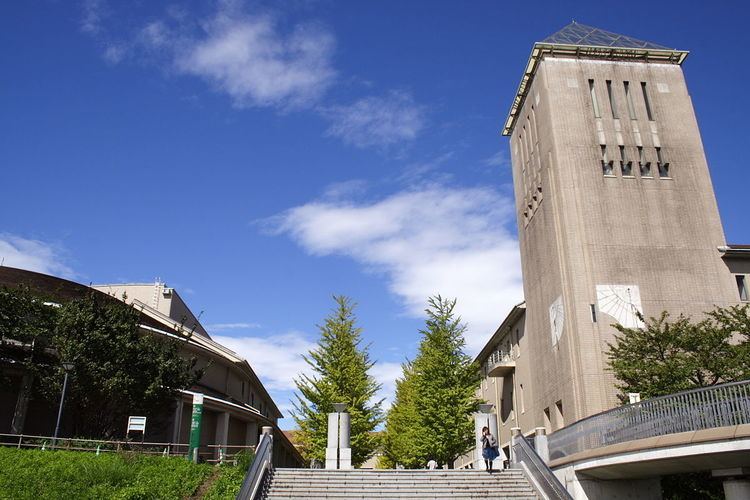Type Public Postgraduates 1,955 Campus Urban Phone +81 42-677-1111 Undergraduates 6,583 | Academic staff 695 full-time Location Hachioji, Tokyo, Japan Total enrollment 9,304 (1 May 2014) Founded 2005 Doctoral students 454 | |
 | ||
Established 1949 (reformed in 2005) Address 1-1 Minamiosawa, Hachioji, Tokyo 192-0364, Japan Motto To pursue the vision of an ideal human society in a metropolis Notable alumni Mokomichi Hayami, Kai Atō, Nobuo Suga, Keiji Kikkawa, Shinjiro Ono Similar Yokohama National University, Tokyo University of Agricult, Tokyo University of Science, Yokohama City University, Hitotsubashi University Profiles | ||
1k
Tokyo Metropolitan University (首都大学東京, Shuto Daigaku Tōkyō), often referred to as TMU, is a Public Research University in Japan.
Contents
- 1k
- Ecotechtube tokyo metropolitan university
- Origin
- History
- University reform
- Faculties undergraduate
- Graduate schools
- Campuses
- Facilities
- Research Centres
- International Partner Institutions
- Academic reputation
- References
Ecotechtube tokyo metropolitan university
Origin
The origin of Tokyo Metropolitan University was Prefectural Higher School, under the old system of education, established by Tokyo Prefecture in 1929 as the third public higher school. The School was modeled on Eton College, with three years of advanced course and four years of regular course.
The seven-year system had an advantage to assure the entrance to Imperial universities at the age of Middle School, and the typical passway for academic elites before the end of Pacific War was to enter Tokyo First Middle School, proceeding First Higher School and Tokyo Imperial University.
Since the jurisdiction control of Tokyo First Middle School and First Higher School were different, however, Tokyo First Middle School attempted to originally establish the prefectural higher school, whereas the other Middle Schools opposed to the said attempt. Prefectural Higher School was established in 1929 locating in the same site of Tokyo First Middle School, as a result of the opposition.
In 1932, Prefectural Higher School was relocated to 1–1–1 Yakumo, Meguro and became known one if the best higher schools with First Higher School. As the reign of Tokyo Metropolis was enacted in 1943, Prefectural Higher School was renamed to Metropolitan Higher School.
After the reform of the educational system in 1949, Tokyo Metropolitan University (former) was established as a research university consisting of three faculties, namely Faculty of Humanities, Faculty of Science and Faculty of Technology; three years of advanced course was reorganised to Senior High School affiliated to Tokyo Metropolitan University, whereas four years of regular course was restructured to Liberal arts college and other faculties. Five Prefectural Colleges, namely Tokyo Prefectural College of Technology, Tokyo Prefectural College of Science, Tokyo Prefectural College of Machine Industry, Tokyo Prefectural College of Chemical Industry and Tokyo Prefectural College of Women were also merged to Tokyo Metropolitan University. In 1957, Faculty of Law and Economics was separated from Faculty of Humanities, and reorganised as Faculty of Law and Faculty of Economics in 1966.
As expanding its organisation, the university was relocated to 1–1–1 Minami-Osawa, Hachioji in 1991.
The university signed the student exchange agreement with University of Vienna in 1997.
Tokyo Metropolitan University was reformed in 2005 by integrating three metropolitan universities and one junior college: Tokyo Metropolitan University (東京都立大学, Tōkyō Toritsu Daigaku), Tokyo Metropolitan Institute of Technology (東京都立科学技術大学), Tokyo Metropolitan University of Health Sciences (東京都立保健科学大学), and Tokyo Metropolitan college (東京都立短期大学), although its English name for the university has not changed since 1949.
History
The following history includes the former institution of Tokyo Metropolitan University.
University reform
In later 1990s, Government and local municipalities facilitated to reform the administrative scheme and financial management in line with economic bubble burst and financial difficulties due to Japan's progressive low birthrate and longevity. As a part of the said administrative and financial reform, social interest grew on restructuring national and public universities to independent administrative agencies with consolidating them. Tokyo Metropolitan University was also planned by Tokyo Metropolitan Government to be consolidated with aforementioned three metropolitan universities and one junior college.
As a result of Tokyo gubernatorial election in April 2003, Shintaro Ishihara was re-elected as Governor of Tokyo, holding up a promise "I will establish a revolutionary university", and consequently the original restructure plan was significantly and rapidly changed, in terms of the organisation of faculties, course structure, etc. During this process, many faculty staff left the university for making strong protest against the reform.
Faculties (undergraduate)
Graduate schools
Campuses
Facilities
Research Centres
Lecturers of the university has been all highly regarded in their respective fields, and the standard of the research carried out by each of them has been considered as extremely high. In line with this, research groups that produce outstanding results and have the potential to become international research hubs, or those working in unique fields that are aligned with the university's mission, are designated as "research centres" and given support by the university.
International Partner Institutions
The university has concluded agreements with the overseas educational institutions with the aim of promoting international cooperation in education and research as well as student exchange.
Academic reputation
Although its small size and young history in contrast to national universities and several leading private universities, the university has been one of the most reputable institutions in Japan. According to the Times Higher Education World University Rankings, it ranks 7th in 2014–2015 among 781 universities in Japan, behind renowned national universities, namely University of Tokyo, Kyoto University, Tokyo Institute of Technology, Osaka University, Tohoku University and Nagoya University. The university received the highest score of 100.0 for "citations.”
In 2012, Prof. Masatake Haruta was selected as a Thomson Reuters Citation Laureate as a possible winner of the Nobel Prize for his "independent foundational discoveries of catalysis by gold."
